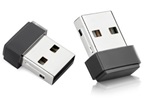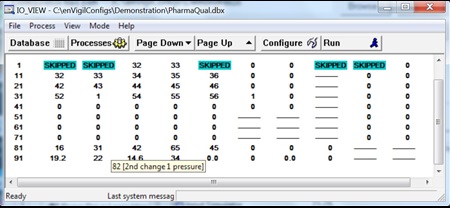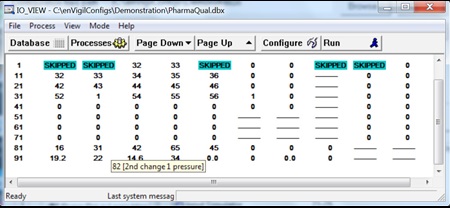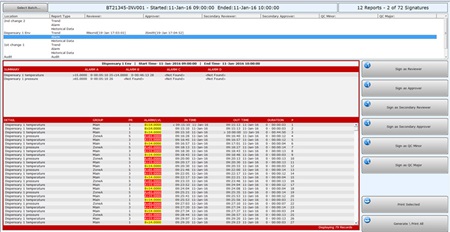enVigil-FMS Environmental Monitoring System
enVigil-FMS offers a configurable environmental monitoring software system aimed at Pharmaceutical, Healthcare, Electronic, and Satellite production facilities. enVigil-FMS has evolved from many years of applications with a need to address the regulatory requirements of EU-GMP, CGMP, GAMP and associated standards.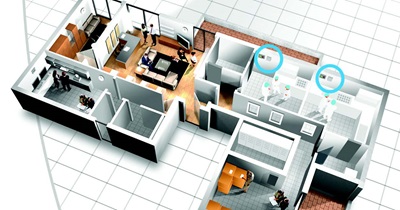
- Multi-level mimic diagrams
- Drivers for multiple particle counters, air samplers and environmental sensors
- Trends displays with multiple cursors
- Reconciled alarm reports with Trend Metrics
- Particle Monitoring Compliance Predictor
- Alarm message displays and beacons
- Interfaces to external systems via OPC, ModBus and ODBC/SQL database applications
- SMS text and email alerts
- Server/Client architecture with network clients
- Hot standby functionality
- Batch reporting with electronic signatures
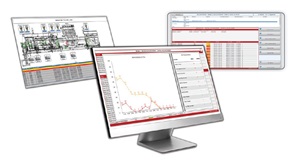
enVigil-FMS is available as both development and runtime licenses with license sizes of 200 and 500 Input/Output (I/O) point database. Up to 128 individual tasks can run concurrently within the enVigil-FMS application and these can range from individual I/O drivers, SMS text /email communications, autoarchiving, real time calculations, scheduling, batch reporting and ModBus/OPC interfaces.
System Deployment
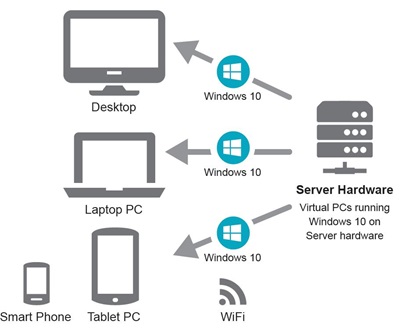 enVigil-FMS can be configured to run on a single PC running on the Windows operating systems to a full Windows Server based applications running on virtual machines with optional Hot Standby functionality.
enVigil-FMS offers both software security registration and USB hardware security. Software security registration is important for virtual machine deployments as the virtual machine does not require access to a USB security key.
enVigil-FMS can be configured to run on a single PC running on the Windows operating systems to a full Windows Server based applications running on virtual machines with optional Hot Standby functionality.
enVigil-FMS offers both software security registration and USB hardware security. Software security registration is important for virtual machine deployments as the virtual machine does not require access to a USB security key.
Virtual Machine Platform
A Virtual Machine offers a number of significant benefits over the more traditional system deployment with multiple PC’s monitoring individual zones within a facility. Server hardware is used to run multiple copies of virtual Windows OS allowing multiple copies of enVigil-FMS to be deployed. Network thin clients are then used to view and control each copy of enVigil-FMS.
- VirtualBox
- VMware
- Windows Virtual PC
- Citrix
- Parallels (Mac)
- HyperV
The benefits can be briefly described as follows:
- Reduction in cost and maintenance as less PC hardware required.
- More secure data repository in one place maintained by IT department.
- Individual desktop (thin client) view nodes offer facility monitoring view to the required users.
- Reduction in energy usage.
enVigil-FMS Server
IOView: Input/Output Database
enVigil V offers a 10,000 point real time database allowing data from non-viable particle counters, viable air samplers, environmental sensors and other input/output devices to be configured. The real time database configurator - IO View enables configuration of the following:
- Points descriptors and identifiers (tags)
- Trend Group point allocation and scale definition
- Alarm level set-points - up to 4 set-points per database point (A, B, C and D)
- Alarm group definition including alarm priority, time delays, alarm inhibit and output functionality
- Alarm acknowledgement definition, either manual or automatic
- Alarms can be inhibited under password control to stop nuisance alarms when equipment or rooms are out of service
- Ancillary functions, such as linear scale and offset to convert sensor inputs (4-20mA) to real world signals such as differential pressure, temperature and humidity
The real time database is the heart of the enVigil-FMS system and provides a simple “window” into the functionality of the configured application. The real time database may be imported and exported as a CSV format file for simple configuration, documentation and maintenance.
Drivers and ModBus Service
enVigil-FMS offers a number of I/O drivers including the following hardware:
Particle Counters and Active Air Samplers:
- MET ONE 6000/7000/3400 particle counters
- Pharmagraph iVAS Air Samplers
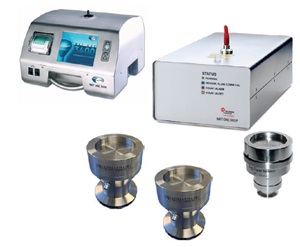
Data Acquisition I/O Hardware:
- Pharmagraph Series 2000, MX5000 and MX6000 series
- Adam 5000 series
- Datascan 7000 and Solo series
- A range of PLCs and I/O systems that use ModBus RTU or TCPIP interfaces.

Additional drivers are also being added as the enVigil-FMS system evolves.
Calculator
enVigil-FMS offers a real time calculator to support additional mathematical requirements, such as the calculation of room differential pressures from measured room absolute pressures. The Calculator offers a powerful scripting language which supports many mathematical functions. It also provides logical functions such as If – Then - Else, Do – While and other common functional statements. The calculated points can then be allocated into the enVigil-FMS database to be configured as a normal I/O point and have alarm and trend definitions applied.
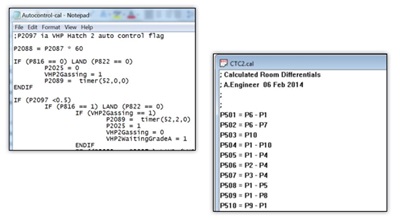
Alarm Indication
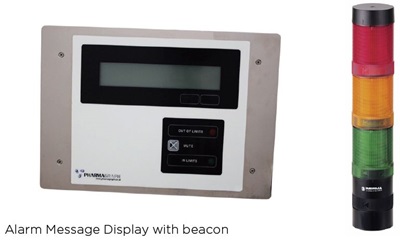 enVigil-FMS has a range of alarm indication hardware ranging from simple alarm beacons with sounders to alarm message displays and network view nodes. The alarm indicators are placed in operational areas to notify personnel of warning and alarm occurrences. Alarm message displays provide further information as to the actual alarm information on the integrated LCD display screen. Sounders may be locally muted at the Alarm Message Display and re-armed if the alarm is not acknowledged within a suitable time period.
enVigil-FMS has a range of alarm indication hardware ranging from simple alarm beacons with sounders to alarm message displays and network view nodes. The alarm indicators are placed in operational areas to notify personnel of warning and alarm occurrences. Alarm message displays provide further information as to the actual alarm information on the integrated LCD display screen. Sounders may be locally muted at the Alarm Message Display and re-armed if the alarm is not acknowledged within a suitable time period.
Hot Standby
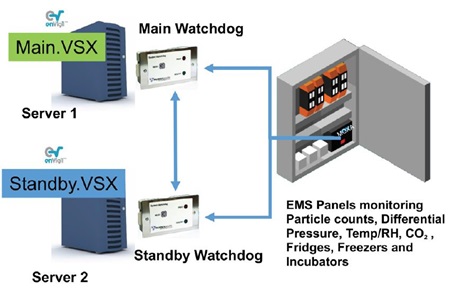 Hot standby functionality can be offered for critical systems by the implementation of Watchdog modules (WD1220N). Main and Standby PC’s are deployed, and each is connected to a Watchdog module. The Watchdog module monitors the internal processes (data logging, system health etc) of the enVigil-FMS applications running on each of the Main and Standby PCs. If the Standby Watchdog module detects a system failure in the Main PC, it initiates a controlled switch over to the Standby PC to take control of the I/O hardware and maintain system functionality.
Hot standby functionality can be offered for critical systems by the implementation of Watchdog modules (WD1220N). Main and Standby PC’s are deployed, and each is connected to a Watchdog module. The Watchdog module monitors the internal processes (data logging, system health etc) of the enVigil-FMS applications running on each of the Main and Standby PCs. If the Standby Watchdog module detects a system failure in the Main PC, it initiates a controlled switch over to the Standby PC to take control of the I/O hardware and maintain system functionality.
Network Clusters
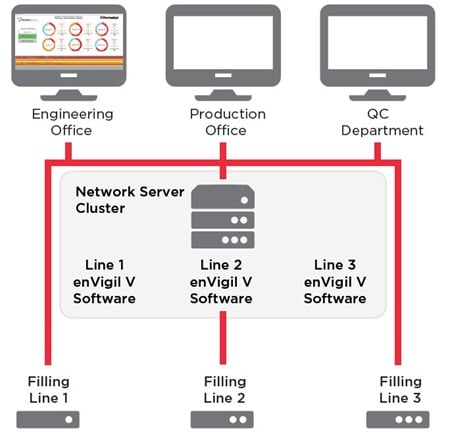
enVigil-FMS now offers capability for multiple servers to connect to distributed network view nodes in a network cluster. Aimed at the increased deployment of enVigil systems running on server and virtual machine platforms, the network cluster offers unrivalled oversight of your monitoring system installations.
Multiple filling suites can be managed through individual enVigil-FMS server applications running a self-contained monitoring system for each line. This enables system deployment to be easily achieved in terms of commissioning, verification and validation without interruption to existing filling suites.
The network cluster topology enables personnel from Production, Engineering and Quality Control to have easy oversight of each filling suite. Coupled with the enVigil-FMS dashboard mimic it provides meaningful information with regard to production performance, alarm management, batch reporting/sign off and any failure investigations that maybe required.
SMS Text/ Email on Alarm
 SMS Text and email alerts can be configured on the system allowing multiple recipients to receive warning and alarm alerts dependent upon alarm groups, time period, weekday or weekend cover. A simple configuration screen allows up to sixteen “call rules” to be defined with individual people alerted when the rule is affirmed.
SMS Text and email alerts can be configured on the system allowing multiple recipients to receive warning and alarm alerts dependent upon alarm groups, time period, weekday or weekend cover. A simple configuration screen allows up to sixteen “call rules” to be defined with individual people alerted when the rule is affirmed.
Instrument Tracking
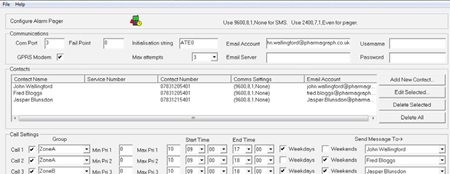 enVigil-FMS includes an instrument tracking facility. Provision of this facility enables both production and QC personnel to know which instruments were used in which sampling positions. Therefore, if there are any production related issues, which involve the particle monitoring system, then the instrument tracking facility can assist in the identification and root-cause investigation of any instrument failings. The instrument tracking facility also offers “Calibration Due” alerts (warnings) and actions (alarms) which will alert production personnel of an instrument calibration service becoming due.
enVigil-FMS includes an instrument tracking facility. Provision of this facility enables both production and QC personnel to know which instruments were used in which sampling positions. Therefore, if there are any production related issues, which involve the particle monitoring system, then the instrument tracking facility can assist in the identification and root-cause investigation of any instrument failings. The instrument tracking facility also offers “Calibration Due” alerts (warnings) and actions (alarms) which will alert production personnel of an instrument calibration service becoming due.
Data-logging
enVigil-FMS offers data logging to secure 21 CFR Part 11 compliant log files which cannot be modified, deleted or altered. enVigil-FMS creates four log files which are individually created on a daily basis. These are detailed as follows:
- Periodic logging which takes a snapshot of the data from the enVigil-FMS database typically every thirty seconds.
- Alarm logging occurs when an individual point transitions a warning (alert) or alarm (action) limit, when the transition is acknowledged with a comment and when the point transitions out of the warning (alert) or alarm (action) limit.
- Audit logging which occurs when a system database configuration change occurs, a user logs in/out or a system health/error is detected.
- System state file which logs the status of specific database points, such as which particle counters are enabled. This enables a Standby PC to maintain the I/O system functionality upon aMain/Standby system changeover.
All data logs are maintained in a year/month directory structure. System log files can be exported to ODBC/SQL database applications with a SQL Utility.
enVigil-FMS Client Interface
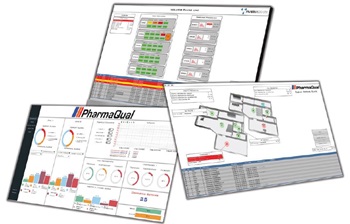
Dashboards
enVigil-FMS offers a multifunction dashboard interface allowing overviews of production lines or facilities to be monitored remotely. Typically configured to provide production management personnel with an overview of how each production facility is performing with the number of alarms, warnings, acknowledgement times, stoppage times and other batch related information.
Mimic Displays
enVigil-FMS provides a configurable client interface allowing multi-level mimic displays to be configured. This includes alarm indicators, point value tables, conditional text, control buttons, graphic images including jpg, bmp images which can then be animated. Simple point and click access from the onscreen alarm indicators provides further access to trend, alarm and historic reports.
Alarm acknowledgement is available from a preconfigured comments list and/or free text entry by the user. Network clients are supported with Terminal Services access to the enVigil-FMS server allowing simple system configuration and verification activities to be easily completed.
The user interface is securely configured with multiple levels of User access: Operator, Supervisor Manager and System Administrator. Logged on users with Supervisor privileges and above can access Alarm Inhibit functionality for rooms or equipment that are out of service, thereby avoiding nuisance alarms being triggered.
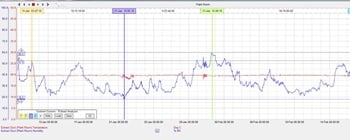
Trend Displays/Reports
enVigil-FMS offers an advanced trending package which supports up to eight concurrent traces with individual scales as required. The trending package can be switched between real time and historic functions at the click of the mouse. Multiple cursors are provided allowing significant event periods to be easily determined. Alarm limits and individual traces can be switched on/off to facilitate easy reading.
Reconciled Alarm Reports with Trend Metrics
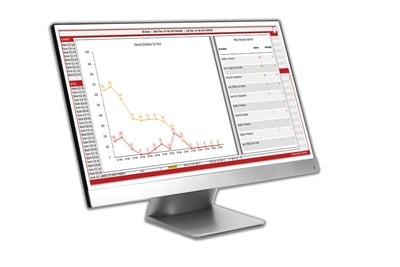
Reconciled alarm reports provide concise alarm event reports to be produced. The reconciled alarm report provides individual points with an alarm summary showing how long a point has been in alarm in each time period. The alarm summary report provides “in to alarm” and “out of alarm” transitions with the total amount of time spent in alarm, acknowledgement comments and an easy way to determine monitored equipment or room malfunctions. The reconciled alarm report allows a succinct way of providing alarm data to support inspection and CAPA reporting requirements.
Detailed Trend Metric reports are also included allowing analysis of alarm trends for alert, action and error transitions over selected time periods supporting FDA and EU-GMP Quality Risk Management (QRM) requirements. These enable management to determine failing plant or additional training for staff.
Historic Tabular Reports
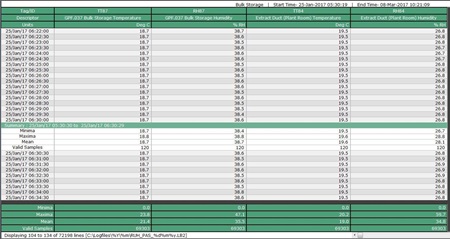
Historic tabular reports also provide max, min, average, number of valid samples and summary data allowing detailed analysis reports to be printed. Data can also be exported to Microsoft Excel in XML format with individual spreadsheets being provided for data, alarm and audit logs. However, the primary 21 CFR Part 11 records are still maintained securely by enVigil-FMS.
Batch Reports with Electronic Signatures
 The optional Batch Reporting package provides an integrated approach to generating batch records. Process templates can be configured to suit particular product campaigns and saved on the system. Batch reports can then be generated for specific production runs within a product campaign. The Batch Reporting package provides up to six electronic signees, such as operator, supervisor/reviewer, QC and QP, who can apply their electronic signature to enable batch release.
The optional Batch Reporting package provides an integrated approach to generating batch records. Process templates can be configured to suit particular product campaigns and saved on the system. Batch reports can then be generated for specific production runs within a product campaign. The Batch Reporting package provides up to six electronic signees, such as operator, supervisor/reviewer, QC and QP, who can apply their electronic signature to enable batch release.



